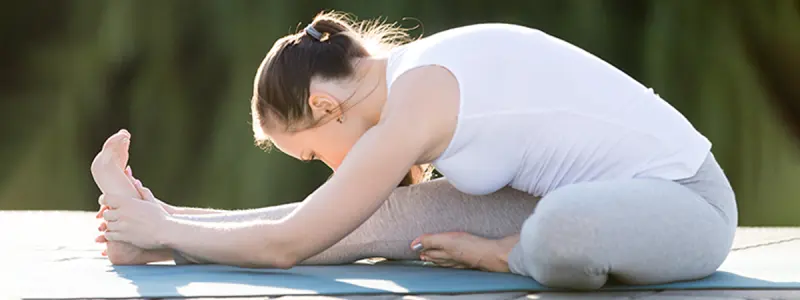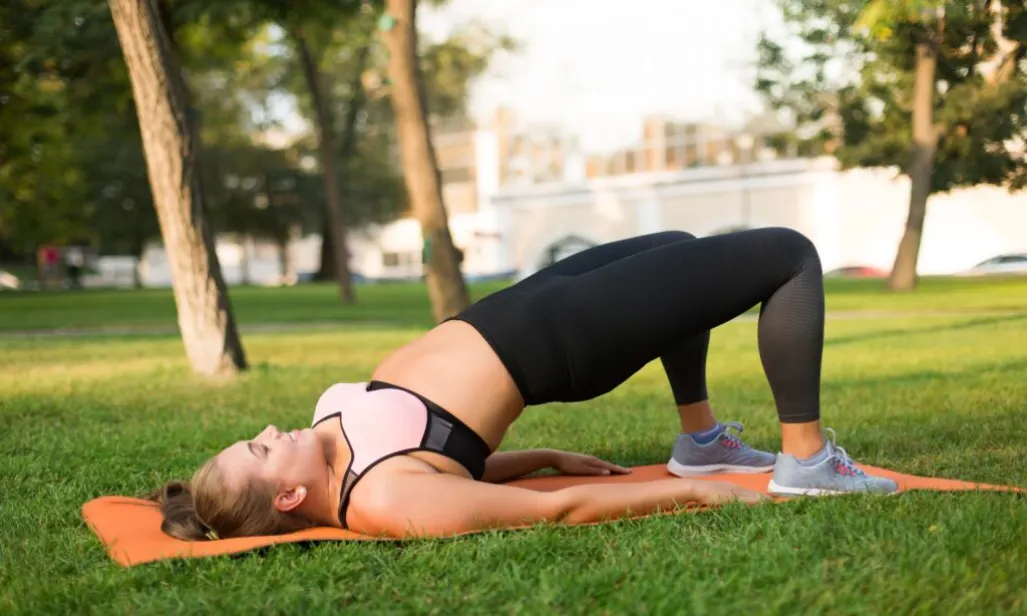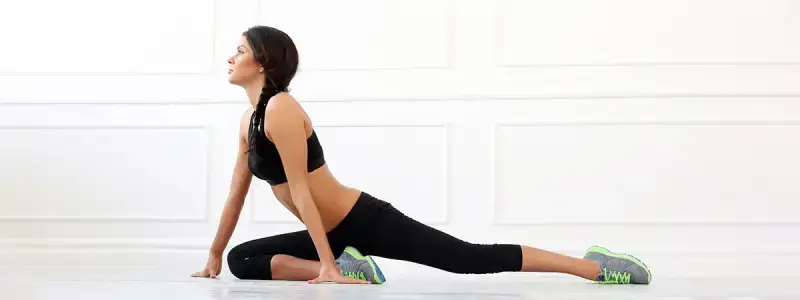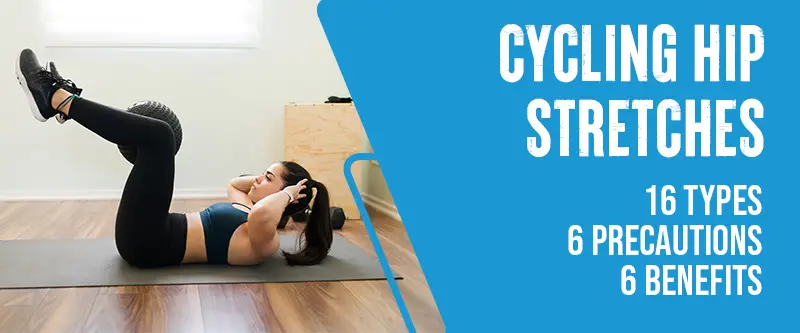You must stretch your hips on and off the bike to maintain a healthy body. Many cyclists need to pay more attention to their mobility training by skipping stretching exercises and avoiding the full range of motion, which can lead to various injuries later on. Your hip flexors should be strengthened and stretched.
To maintain flexibility in your hip area as a cyclist, perform various stretches like standing quad stretch, standing calf stretch, hip and lower back stretch, and hip flexors and psoas stretch.
The hip rotator stretch effectively targets the muscles beneath the glutes. Incorporating these stretches into your routine improves hip flexibility and eases tightness.
In this blog post, we’ll explore different hip stretches for cyclists, the benefits of cycling hip stretches, and the precautions you should take during cycling hip stretches.
Cycling Hip Stretches: 16 Powerful Moves You Must Try

Hip stretches are a crucial part of any cyclist’s routine. The repetitive cycling motion can cause tightness and tension in the hips, leading to discomfort, pain, and even injury. Regularly incorporating hip stretches into your pre and post-ride routine can improve your flexibility, range of motion, and overall performance on the bike. Here are some of the most influential stretches for cyclists’ hips:
✔ Top Pick: Foam Roller
Many cyclists use a foam roller to release tight hip and glute muscles after rides.
- Pigeon Stretch: It targets the hip flexors and glutes. Plank, bring one leg towards your hands, and lean forward to stretch your hips. Hold for 30 seconds before switching to the other side.
- Stacked Knee Stretch: The stacked knee stretch improves flexibility in the hip flexors and quadriceps muscles. It targets the muscles that are tight because of cycling posture and helps in releasing the tension.
- Doorway Stretch: This stretch targets the hip flexors. Stand in a doorway with one foot inside and the other foot outside. Gently lean forward into the stretch if you do not feel any stretch in your hips. Switch to the other side after 30 seconds.
- T-Spine Mobility: This stretch targets the mid-back and glutes. Start in a tabletop position, place one hand behind your head, and open up your chest towards the ceiling while simultaneously lifting and bending one leg. Flip over after 30 seconds.
- Pretzel Stretch: This stretch targets the glutes and hips. Put your knees bent and lie on your back. The ankle of one leg should rest on the opposite thigh. Grab the back of your opposite thigh and pull towards your chest so you feel a stretch in your hip. Afterward, switch sides and hold for 30 seconds.
- Leg Crossover Stretch: This stretch targets the outer hips. You should lie on your back with your knees bent. Lie on your back and gently lower your legs towards the ground on the opposite side until you stretch your hip. After holding for 30 seconds, switch sides.
- Happy Baby Pose: This stretch targets the inner thighs and hips. The first step is to lie on your back and bend your knees. Grab the insides of each foot and pull your knees towards your armpits to feel a stretching sensation in your hips and inner thighs. Hold for 30 seconds.
- Offset Child’s Pose: The offset child’s pose changes the traditional child’s pose. It is an effective way to stretch the hip flexors, glutes, and lower back. This pose helps to release muscle tension and tightness after a cycling ride.
- Deep Squat: The deep squat is a functional movement that targets the glutes, quads, and hip flexors. It is an effective stretch that helps release tightness in the hip muscles.
- Posterior Lunges: Posterior lunges are an excellent exercise for stretching hip flexors, glutes, and hamstrings. This stretch targets the muscles in the back of the hip joints, which can become tight because of cycling.
- Twisting Glute Stretch: The twisting glute stretch targets the hips and lower back muscles. Stretching your hip muscles helps release tightness.
- The Pretzel Stretch: The pretzel stretch is a classic yoga pose that targets the outer hips and glutes. To perform this pose, sit with one leg bent towards you and the other leg crossed over, forming a “pretzel” shape. Gently lean forward to deepen the stretch, feeling the tension release in your hips and buttocks.
- Hip Opening Stretches: Hip opening stretches encompass a range of exercises designed to increase flexibility and loosen tight hip muscles. These stretches often involve dynamic movements that engage the hip flexors, abductors, and adductors.Incorporating a variety of hip opening stretches can help cyclists improve their range of motion and prevent stiffness during rides.
- Hip Crossover Stretch: The hip crossover stretch effectively targets the outer hips and lower back. Backwards with arms extended to the sides. Cross one leg over the other, allowing your hips to rotate naturally.Hold the position for a few breaths, then switch sides. This stretch helps ease hip tension and promotes spinal alignment, essential for cyclists seeking improved performance.
- Pretzel Glute Stretch: This is a variation of the traditional pretzel stretch that focuses specifically on the glute muscles. Sit on the floor, cross your leg over your knee, and gently twist your torso towards the crossed leg.This stretch benefits the glutes and releases tension around the hips, improving hip health for cyclists.
- Hip Crunch: The hip crunch is a dynamic exercise for your core and hips. Put your knees bent and feet flat on the floor. Lift your hips off the ground by contracting your abdominal muscles and squeezing your glutes.This movement strengthens the hip flexors and stabilizes the pelvis, which is crucial for cyclists who want to enhance their power output and endurance.
Flexibility Exercises For Cyclists

Improving flexibility is essential for overall well-being and can enhance your cycling performance. Here are some adequate flexibility exercises you can incorporate into your routine:
Dynamic Lunges
- Two to three feet apart, one foot behind, one foot in front.
- Reduce your body until your back knee is a few inches off the ground.
- Put your weight on your front foot and push back up.
- Switch feet after 5–10 reps.
Stair Calf Stretch
- On the bottom step, hang your heels over the edge.
- Slowly drop your heels, holding on to the wall or stair rail.
- Hold this position for 20–30 seconds and repeat two to three times.
Lizard Pose (Utthan Pristhasana)
- You’ll start in Downward-Facing Dog.
- Take a step forward with your right foot, outside of your right hand.
- Put your right knee at a 90-degree angle and don’t let it go forward further than your ankle.
- Hold your shoulders above your wrists while bending your elbows until your forearms are on the floor.
- Hold for 10 seconds, then straighten your arms and switch legs.
- Repeat 10 times on each side.
Lying Quad Stretch
- Lie on your right side with your legs straight.
- Pull your left heel toward your left glute.
- Squeeze your hips forward for a deeper stretch.
- Hold for 15–30 seconds and switch sides, repeating one to three times per leg.
Types Of Sit Ups For Cyclist
As a cyclist, incorporating core exercises can enhance your performance and stability. Here are some sit-up variations specifically beneficial for cyclists:
Bicycle Crunch
- Lie flat on your back.
- Your lower abs should be contracted to lift your legs.
- Simultaneously bring your right elbow toward your left knee while extending your right leg straight.
- Alternate sides in a pedaling motion.
- Targets: Mid-abs, lower abs, and obliques.
Seated Russian Twist
- Place your feet on the ground and bend your knees.
- Hold a weight or medicine ball.
- Your torso should be twisted from side to side, tapping the ground.
- Engages obliques and improves rotational stability.
Decline Sit-Up
- Perform a standard sit-up on a decline bench (head lower than feet).
- Strengthens lower abs and hip flexors.
- Muscles targeted: Entire core, especially lower abs.
V-Sit
- Place your legs on the floor and your upper body leaning back.
- Lift legs and upper body simultaneously, forming a V shape.
- Enhances overall core strength and stability.
Hip Stretching Techniques for Cyclist
Stretching is crucial for cyclists to maintain flexibility and prevent injuries, particularly in the hips which can become tight because of prolonged periods of sitting and repetitive pedaling motions. Here are some techniques to stretch various muscles and areas around the hips:
Hip Adductors Stretch
- Seated Groin Stretch: Lie on the floor with your legs extended straight out before you. Then, bend your knees and bring your foot soles together. Kneel down with your elbows pressed gently towards the floor.
Hip Muscles Stretch
- Pigeon Pose: Hold a plank pose, then bring one knee forward and place it near your wrist on the same side. Extend the opposite leg back, keeping your hips square. Lower your hips towards the floor to feel the stretch in the hip of the front leg.
Outside Hip Stretch
- IT Band Stretch: Stand upright and cross one leg behind the other. Lean to the side of the back leg, reaching towards the opposite direction with your arm overhead. It should feel like a stretch along your hip and thigh.
Hip Joint Stretch
- Supine Hip Flexor Stretch: Lie on your back with one leg bent and one straight. Bring the bent knee towards your chest while keeping the other leg straight. Hold for a moment, then switch sides.
Sides of Hips Stretch
- Standing Side Stretch: Put your feet hip-width apart. Reach one arm overhead and lean towards the opposite side, squaring your hips. You should feel a stretch along the side of your body and hips.
Inner Hip Stretch
- Butterfly Stretch: Bend your knees and put your feet together as you sit down. Hold onto your feet with your hands and gently press your knees towards the floor.
Hip Stretches in Bed
- Supine Figure Four Stretch: Lie on your back in bed. Put one ankle over the other knee to create a “4” shape with your legs. Hold onto the back of the uncrossed thigh and gently pull towards your chest.
90/90 Hip Stretch
- Seated 90/90 Stretch: Bend one knee 90 degrees in front of you and the other bent behind you. Put your hips forward tostretch both hips.
Hip Bursitis Stretch
- Quadriceps Stretch: Stand upright and grab one ankle with your hand, bringing it towards your glutes. Be sure to keep your knees close together and your torso upright. You should feel a stretch in the front of your hip.
6 Precautions To Take During Cycling Hip Stretches

You’ll feel better, have more flexibility, and have a lower risk of injury when you stretch your hips. Taking proper precautions when performing hip stretches is crucial to prevent injuries and maximize benefits. Here are some essential precautions to keep in mind:
Start Slowly
It’s important to ease into your cycling hip stretches gradually. Don’t push your body too hard too fast, as this can lead to injury. Try starting with a gentle warm-up, such as a short walk or light jog, before stretching your hips.
Avoid Overstretching or Bouncing
Overstretching and bouncing can also lead to injury. Instead, try to hold your stretches for 20-30 seconds and then release slowly. Repeat each stretch 2-3 times, taking breaks in between if necessary.
Listen to Your Body and Stop if There Is Pain
If you feel any pain or discomfort, stop your cycling hip stretches. Pain is your body’s way of telling you that something is wrong. If pain persists or worsens, consult a healthcare professional.
Use Proper Form
It’s essential to follow proper form when stretching. Ensure your body is aligned correctly during each stretch, and breathe deeply and calmly. Consult a professional for guidance if you need clarification on the proper form.
✔ Top Pick: Yoga Mat
A non-slip yoga mat provides a comfortable surface for performing hip stretches safely.
Gradual and Gentle Stretching
For stretching, slow and steady wins the race. Make sure you start your hip stretching routine gradually and gently, taking time to loosen up the muscles. Don’t push yourself into a stretch too quickly or far, as it can cause strain and injury. Instead, hold each stretch for 15-20 seconds and repeat 2-3 times, accumulating the intensity.
Consulting a Professional if Necessary
If you have any previous injuries or medical conditions or don’t know how to perform a specific cycling hip stretch, it’s always a good idea to consult a professional. You can get help from a physical therapist or sports medicine doctor to help you design a safe stretching routine tailored to your needs and abilities.
6 Benefits of Cycling Hip Stretches
A regular cycling routine incorporating targeted hip stretches will enhance your overall flexibility and reduce your risk of injury. Here are some benefits of cycling hip stretches:
Improved Hip Flexibility
The hips are an essential part of the body for cyclists. Increased cycling hip mobility can lead to better pedaling mechanics and reduced strain on the lower back. Among the benefits of improved hip flexibility for cyclists are:
- Increased range of motion: With higher hip flexibility, you can move your legs in a broader range of movement, leading to more efficient pedaling and less discomfort.
- Reduced muscle strain: Tight hip muscles strain your back, pelvis, and legs. Improving hip flexibility will minimize the risk of muscle strain and potential injury.
- Improved circulation: Hip stretches can help increase blood flow to the hip muscles, allowing nutrients and oxygen to reach the area and promote healing. Biking is good for hip flexor injury.
Promoted Better Balance
Maintaining outstanding balance while cycling is crucial for your safety and performance. The following are some benefits of improved balance for cyclists:
- Increased stability: You can maintain a stable riding posture with better balance, reducing injury risk and improving performance.
- Reduced fatigue: Good balance requires less effort, helping conserve energy and reduce fatigue.
- Improved control: Better balance allows you to have greater control over your bike, which can increase your confidence and help you tackle challenging terrain.
Enhanced Athletic Performance
Hip stretches can help enhance your athletic performance in a variety of ways. Here are some benefits of improved athletic performance that cyclists can enjoy:
- Increased power: With better flexibility in your hips, you’ll generate more power in your pedal stroke, leading to faster speeds and better endurance.
- Improved agility: Good hip mobility allows you to make quick movements on your bike, which can be beneficial for navigating tight turns or dodging obstacles.
- Reduced risk of injury: By improving overall flexibility and balance, you’ll be less likely to sustain an injury and increase your ability to ride at peak performance levels.
Reduced Muscle Soreness

Cycling can lead to sore, tight hip and lower back muscles. Hip stretches can help ease this discomfort by increasing blood flow and releasing tension. These are some benefits of reduced muscle soreness that cyclists can enjoy:
✔ Top Pick: Massage Gun
A massage gun is used by many cyclists to relieve hip and lower back muscle soreness after long rides.
- Faster recovery: By stretching out tight muscles after a ride, you’ll be able to recover faster and get back on your bike sooner.
- Reduced pain: Hip stretches can help reduce pain and discomfort associated with muscle soreness, allowing you to ride in greater comfort.
- Increased flexibility: Over time, consistent stretching can lead to increased hip flexibility, reducing the likelihood of muscle soreness in the future.
Alleviated Lower Back Pain
Lower back pain is a common complaint among cyclists, often caused by improper posture and excessive strain on the lower back muscles. By stretching your hips, you can ease lower back pain in the following ways:
- Improved posture: By improving hip flexibility and overall mobility, you’ll be better able to maintain a correct posture on your bike, reducing strain on the lower back.
- Reduced inflammation: Stretching can help reduce inflammation in the hip and lower back muscles, leading to less pain and discomfort.
- Increased blood flow: Better circulation through hip stretches can help nourish the muscles in your lower back, which leads to less pain and improved function.
Less Injury
Incorporating hip stretches into your cycling routine is excellent for preventing injuries. Here are some benefits of reduced injury that cyclists can enjoy:
- Improved flexibility: By consistently stretching hip muscles, you’ll improve your overall flexibility and reduce the likelihood of muscle strains and sprains.
- Reduced stress on joints: By promoting better balance and good posture, hip stretches can reduce joint strain, leading to less risk of injury.
- Increased muscle strength: As your muscles become more flexible through stretching, they become more robust, leading to excellent joint stability and reduced injury risk.
Conclusion
Hip stretches may be outside of mind for many cyclists, but they are essential to your overall health and performance. Proper stretching can improve flexibility and reduce the risk of injury while helping you achieve better posture and more power on your bike.
So, next time you hit the road or the trainer, remember to take a few minutes to stretch out your hips and surrounding muscles. With consistent stretching, you’ll be amazed at the difference in your cycling performance and overall happiness on the bike.
FAQs
Why Do My Hips Pop When I Stretch?
The tendon connects muscles to bones. Your hip joint makes a popping noise when the tight tissue crosses over a bony ridge. Pain rarely comes with this.
Why Do I Have Stretch Marks on My Hips?
Stretch marks on the hips can be caused by rapid growth, weight gain or loss, hormonal changes, or genetic predisposition. The skin stretches beyond its elastic capacity, resulting in stretch marks.
Can Stretching Make Your Hips Wider?
Wider hips are primarily determined by bone structure and genetics, so significantly altering your hip width through exercise alone is impossible. However, specific exercises can help strengthen and develop the muscles around the hips, improving overall hip appearance and shape.
Can Stretching Make Hip Pain Worse?
Exercise should not make your existing hip pain worse overall. As your body gets used to moving differently, new exercises can sometimes cause short-term muscle pain. Exercise should relieve this kind of pain fast, and your pain shouldn’t be worse in the morning.
Why Are Hip Stretches Beneficial For Cyclists?
Hip stretches help to lengthen and loosen the hip muscles that can become tight and strained during cycling. They also improve hip joint mobility and stability, reducing the risk of cycling-related injuries.
How Do You Stretch Your Hips When Cycling?
Assume a lunge position by taking a significant step forward, bending your front knee over your front foot, and fully extending your back leg behind you. Make sure the top of your back foot is flat on the floor. Keep your back straight and nuzzle your hips forward until you feel a slight stretch in your groin/hip area.


